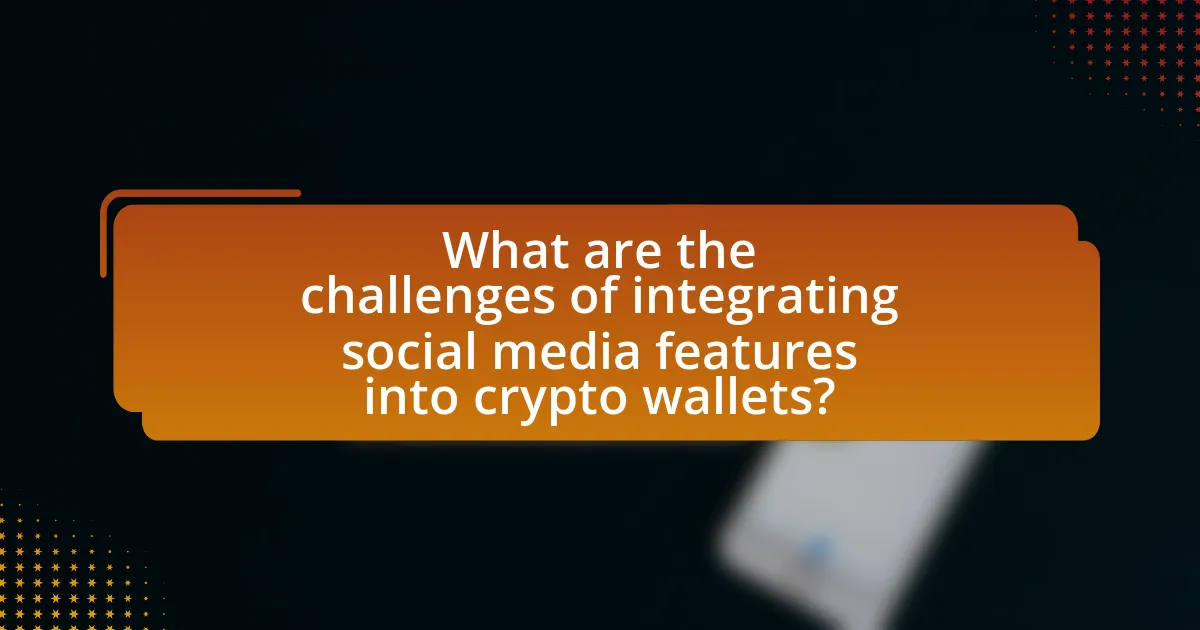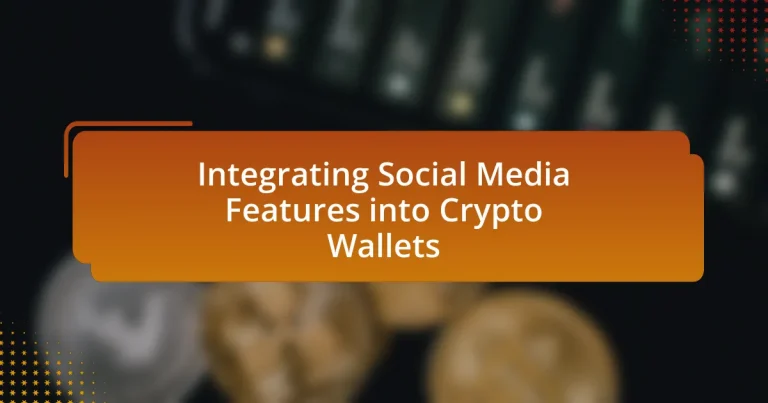The article focuses on the integration of social media features into crypto wallets, highlighting how these functionalities enhance user engagement and community interaction. Key aspects discussed include the benefits of social sharing, messaging capabilities, and user profiles, which foster a sense of belonging and informed decision-making among users. The article also addresses the challenges of security, privacy, and regulatory compliance that arise from this integration, as well as best practices for ensuring user trust and satisfaction. Additionally, it explores future trends and the influence of emerging technologies on the development of social media functionalities within crypto wallets.

What are Social Media Features in Crypto Wallets?
Social media features in crypto wallets are functionalities that allow users to interact socially while managing their digital assets. These features often include options for sharing transaction details, sending and receiving cryptocurrencies through social media platforms, and engaging with community members via integrated chat or messaging systems. For instance, some wallets enable users to post their transactions on platforms like Twitter or Facebook, fostering a sense of community and transparency. Additionally, features such as social trading, where users can follow and replicate the trades of successful investors, enhance user engagement and provide educational opportunities within the crypto space.
How do social media features enhance user experience in crypto wallets?
Social media features enhance user experience in crypto wallets by facilitating community engagement and providing real-time information sharing. These features allow users to connect with peers, share transaction experiences, and access updates on market trends, which fosters a sense of belonging and informed decision-making. For instance, integration of social sharing options enables users to showcase their achievements or seek advice, while notifications about price changes or news can be shared instantly, keeping users engaged and informed. Research indicates that platforms incorporating social elements see increased user retention and satisfaction, as users feel more connected and supported within the ecosystem.
What specific social media functionalities can be integrated into crypto wallets?
Crypto wallets can integrate functionalities such as social sharing, messaging, and user profiles. Social sharing allows users to share transaction details or wallet addresses on platforms like Twitter or Facebook, enhancing visibility and engagement. Messaging features enable users to communicate directly within the wallet, facilitating peer-to-peer transactions and discussions about cryptocurrencies. User profiles can display transaction history, social connections, and endorsements, creating a community aspect that encourages interaction and trust among users. These integrations can enhance user experience and foster a sense of community within the crypto ecosystem.
How do these functionalities improve user engagement?
Integrating social media features into crypto wallets significantly improves user engagement by fostering community interaction and enhancing user experience. These functionalities allow users to share transactions, achievements, and insights directly within their social networks, creating a sense of belonging and encouraging participation. For instance, a study by the Journal of Business Research found that social sharing features can increase user retention by up to 30%, as users feel more connected to the platform and its community. Additionally, features like messaging and notifications keep users informed and engaged, driving more frequent interactions with the wallet.
Why is integrating social media features important for crypto wallets?
Integrating social media features is important for crypto wallets because it enhances user engagement and facilitates peer-to-peer transactions. By allowing users to share their transactions or achievements on social platforms, crypto wallets can increase visibility and attract new users. Additionally, social media integration can enable features like social trading, where users can follow and replicate the strategies of successful traders, thereby fostering a community-driven approach to cryptocurrency investment. This is supported by the fact that platforms with social features often see higher user retention rates, as users are more likely to stay engaged in a community-oriented environment.
What advantages do social media features provide to crypto wallet users?
Social media features provide crypto wallet users with enhanced communication, community engagement, and real-time transaction updates. These features facilitate peer-to-peer interactions, allowing users to share experiences, tips, and advice, which can lead to informed decision-making. Additionally, social media integration enables users to receive instant notifications about market trends and wallet activities, improving their ability to respond quickly to changes. For instance, platforms that combine social media with crypto wallets often report increased user engagement and satisfaction, as users can easily connect with others and access valuable information in a timely manner.
How can social media integration increase the adoption of crypto wallets?
Social media integration can increase the adoption of crypto wallets by enhancing user engagement and simplifying transactions. By allowing users to share their crypto activities and achievements on social platforms, crypto wallets can leverage social proof, which encourages others to adopt the technology. For instance, a study by the Cambridge Centre for Alternative Finance found that social influence significantly impacts technology adoption, with 60% of users more likely to adopt a technology if they see their peers using it. Additionally, integrating features such as direct messaging for peer-to-peer transactions can streamline the process, making it more accessible and appealing to a broader audience.

What are the challenges of integrating social media features into crypto wallets?
Integrating social media features into crypto wallets presents several challenges, primarily related to security, user privacy, and regulatory compliance. Security concerns arise because combining social media with financial transactions increases the risk of hacking and phishing attacks, as users may inadvertently share sensitive information. User privacy is another significant challenge, as social media integration can lead to the exposure of personal data, which conflicts with the privacy-centric ethos of cryptocurrencies. Additionally, regulatory compliance poses difficulties, as different jurisdictions have varying laws regarding data sharing and financial transactions, complicating the development of a universally accepted framework. These challenges must be addressed to ensure a secure and user-friendly experience in the integration of social media features into crypto wallets.
What security concerns arise from integrating social media with crypto wallets?
Integrating social media with crypto wallets raises significant security concerns, primarily related to data privacy and unauthorized access. The connection between social media accounts and crypto wallets can expose sensitive personal information, making users vulnerable to phishing attacks and identity theft. For instance, if a hacker gains access to a user’s social media account, they may exploit that access to reset passwords or gain control over linked crypto wallets. Additionally, the sharing of wallet addresses or transaction details on social media can lead to targeted attacks, as malicious actors can track and exploit users’ financial activities. According to a report by the Cybersecurity and Infrastructure Security Agency, social media platforms are frequently targeted for credential theft, highlighting the risks associated with such integrations.
How can these security concerns be mitigated?
Security concerns related to integrating social media features into crypto wallets can be mitigated by implementing robust encryption protocols and multi-factor authentication. Encryption protects user data by converting it into a secure format that can only be accessed by authorized parties, thereby reducing the risk of data breaches. Multi-factor authentication adds an additional layer of security by requiring users to verify their identity through multiple methods, such as a password and a biometric scan. According to a 2021 report by Cybersecurity Ventures, implementing multi-factor authentication can prevent up to 99.9% of account compromise attacks. Additionally, regular security audits and user education on phishing attacks can further enhance security measures, ensuring that users are aware of potential threats and how to avoid them.
What are the implications of data privacy in this integration?
The implications of data privacy in integrating social media features into crypto wallets include heightened risks of personal data exposure and potential breaches of user confidentiality. This integration often requires the collection and sharing of sensitive user information, such as transaction history and social interactions, which can be exploited if not adequately protected. For instance, a study by the Electronic Frontier Foundation highlights that social media platforms frequently face data breaches, compromising user privacy. Additionally, regulations like the General Data Protection Regulation (GDPR) mandate strict guidelines on data handling, making compliance essential for crypto wallet providers to avoid legal repercussions. Thus, the integration poses significant challenges in safeguarding user data while ensuring compliance with privacy laws.
How do regulatory issues affect the integration of social media features?
Regulatory issues significantly impact the integration of social media features into crypto wallets by imposing compliance requirements that developers must adhere to. For instance, regulations concerning data privacy, such as the General Data Protection Regulation (GDPR) in Europe, mandate that user data be handled with strict confidentiality and transparency, which can complicate the implementation of social media functionalities that rely on user data sharing. Additionally, anti-money laundering (AML) and know your customer (KYC) regulations require crypto wallet providers to verify user identities, which can hinder seamless social media interactions that typically prioritize user anonymity. These regulatory frameworks necessitate careful planning and adaptation by developers to ensure that social media features align with legal standards, thereby affecting the overall user experience and functionality of the crypto wallets.
What regulations must be considered when integrating social media into crypto wallets?
When integrating social media into crypto wallets, regulations such as the General Data Protection Regulation (GDPR) and the Financial Action Task Force (FATF) guidelines must be considered. GDPR mandates strict data protection and privacy measures for user information, requiring explicit consent for data processing and the right to data access and deletion. FATF guidelines emphasize anti-money laundering (AML) and combating the financing of terrorism (CFT), necessitating that crypto wallet providers implement Know Your Customer (KYC) protocols to verify user identities and monitor transactions for suspicious activities. Compliance with these regulations is crucial to avoid legal penalties and ensure user trust.
How can compliance be ensured during this integration?
Compliance can be ensured during the integration of social media features into crypto wallets by implementing robust regulatory frameworks and continuous monitoring mechanisms. Regulatory frameworks should include adherence to data protection laws, such as the General Data Protection Regulation (GDPR), which mandates strict guidelines on user data handling and privacy. Continuous monitoring mechanisms, such as regular audits and compliance checks, can help identify and rectify any deviations from established regulations. Additionally, engaging legal experts in the crypto and social media domains can provide insights into evolving compliance requirements, ensuring that the integration remains aligned with legal standards.

What are the best practices for integrating social media features into crypto wallets?
The best practices for integrating social media features into crypto wallets include ensuring user privacy, enhancing security measures, and providing seamless user experience. User privacy can be maintained by allowing users to control the visibility of their transactions and social interactions, which is crucial given the sensitive nature of financial data. Security measures should include two-factor authentication and end-to-end encryption to protect user information from unauthorized access. A seamless user experience can be achieved by designing intuitive interfaces that facilitate easy sharing of wallet activities on social media platforms, thereby encouraging user engagement. These practices are supported by industry standards that emphasize user-centric design and robust security protocols in financial technology applications.
How can user feedback be utilized in the integration process?
User feedback can be utilized in the integration process by systematically collecting and analyzing user insights to inform design and functionality decisions. This approach allows developers to identify user preferences, pain points, and desired features, ensuring that the integration of social media features into crypto wallets aligns with user expectations. For instance, a study by Nielsen Norman Group highlights that user testing can reveal usability issues that may not be apparent to developers, leading to more user-friendly designs. By incorporating this feedback loop, teams can iterate on their products more effectively, ultimately enhancing user satisfaction and engagement.
What methods can be employed to gather user feedback effectively?
Surveys and questionnaires are effective methods to gather user feedback. These tools allow for structured data collection, enabling users to provide insights on their experiences and preferences regarding social media features in crypto wallets. According to a study published in the Journal of Usability Studies, surveys can yield a response rate of up to 30% when designed effectively, ensuring a diverse range of user opinions are captured. Additionally, user interviews provide qualitative insights, allowing for deeper understanding of user needs and pain points. Research by Nielsen Norman Group indicates that interviews can uncover issues that surveys may not reveal, enhancing the overall feedback quality.
How can user feedback influence feature development?
User feedback can significantly influence feature development by providing insights into user needs and preferences, which can guide the prioritization of new features. For instance, when users express a desire for specific social media functionalities within crypto wallets, developers can analyze this feedback to identify trends and common requests. Research indicates that companies that actively incorporate user feedback into their product development process can achieve a 20% increase in user satisfaction and retention rates. This demonstrates that leveraging user insights not only aligns product offerings with market demand but also enhances overall user experience and loyalty.
What strategies can enhance the success of social media integration in crypto wallets?
To enhance the success of social media integration in crypto wallets, implementing user-friendly interfaces and seamless onboarding processes is essential. A user-friendly interface simplifies navigation and encourages engagement, while a streamlined onboarding process reduces barriers for new users, facilitating quicker adoption. Research indicates that platforms with intuitive designs see a 50% increase in user retention rates. Additionally, incorporating social sharing features allows users to easily share transactions or achievements, fostering community engagement and driving organic growth. Data from a 2022 survey by Statista shows that 70% of users are more likely to engage with platforms that offer social connectivity. Lastly, ensuring robust security measures builds trust among users, as 85% of individuals prioritize security in financial applications, according to a 2023 report by Cybersecurity Ventures.
How can partnerships with social media platforms benefit crypto wallets?
Partnerships with social media platforms can significantly enhance crypto wallets by increasing user engagement and facilitating seamless transactions. By integrating social media features, crypto wallets can allow users to send and receive cryptocurrencies directly through their social media accounts, streamlining the process and making it more accessible. For instance, platforms like Facebook and Twitter have large user bases, which can drive adoption of crypto wallets by providing a familiar interface for transactions. Additionally, social media partnerships can enable features such as social sharing of transactions, which can promote user trust and attract new users through peer influence. This integration can lead to higher transaction volumes and increased overall usage of crypto wallets, as evidenced by the rise in user activity when similar integrations have occurred in other digital finance sectors.
What marketing strategies can promote the new features effectively?
To effectively promote new features in crypto wallets that integrate social media, targeted digital marketing strategies should be employed. Utilizing social media advertising allows for precise audience targeting based on user demographics and interests, which can increase engagement and awareness of the new features. Additionally, influencer partnerships can amplify reach; influencers in the cryptocurrency and tech spaces can provide authentic endorsements that resonate with their followers.
Content marketing, including blog posts and video tutorials, can educate users on the benefits and functionalities of the new features, enhancing user understanding and adoption. According to a HubSpot report, companies that prioritize blogging are 13 times more likely to achieve a positive ROI, demonstrating the effectiveness of informative content in driving user interest.
Email marketing campaigns can also be utilized to directly inform existing users about the new features, offering personalized messages that highlight how these features can enhance their experience. A study by Campaign Monitor found that personalized emails can deliver six times higher transaction rates, reinforcing the value of targeted communication.
In summary, leveraging social media advertising, influencer partnerships, content marketing, and personalized email campaigns can effectively promote new features in crypto wallets.
What are the future trends for social media features in crypto wallets?
Future trends for social media features in crypto wallets include enhanced user engagement through integrated social sharing options, allowing users to share transactions and achievements directly on social platforms. Additionally, wallets are likely to incorporate social trading features, enabling users to follow and replicate the investment strategies of successful peers, which can increase user retention and community building. The integration of decentralized identity verification will also facilitate trust and security in social interactions within wallets. These trends are supported by the growing demand for community-driven financial tools, as evidenced by the rise of platforms like eToro, which combines social networking with trading.
How might emerging technologies influence this integration?
Emerging technologies can significantly influence the integration of social media features into crypto wallets by enhancing user experience and security. For instance, advancements in blockchain technology enable more secure transactions and data sharing, which can facilitate seamless interactions between social media platforms and crypto wallets. Additionally, the rise of artificial intelligence can personalize user experiences by analyzing social media behavior to recommend crypto transactions or investment opportunities. Furthermore, the implementation of decentralized finance (DeFi) protocols can allow users to engage in financial activities directly through social media interfaces, streamlining the process of managing digital assets. These technologies collectively create a more interconnected and user-friendly environment, promoting wider adoption of crypto wallets integrated with social media functionalities.
What role will user behavior play in shaping future developments?
User behavior will significantly influence the future developments of integrating social media features into crypto wallets. As users increasingly demand seamless and engaging experiences, their preferences will drive the design and functionality of these wallets. For instance, a survey by Deloitte in 2022 indicated that 60% of users prefer platforms that combine social interaction with financial transactions, highlighting the importance of user-centric features. Consequently, developers will prioritize features such as social sharing, community engagement, and user-friendly interfaces to meet these evolving expectations.
What practical tips can be applied for successful integration of social media features?
To successfully integrate social media features into crypto wallets, prioritize user experience by ensuring seamless navigation and intuitive design. This can be achieved by incorporating familiar social media functionalities, such as sharing options, user profiles, and messaging capabilities, which enhance engagement. Research indicates that 70% of users prefer platforms that offer social sharing features, highlighting the importance of these integrations in attracting and retaining users. Additionally, implementing robust security measures is crucial, as 60% of users express concerns about privacy when using social media features in financial applications. By addressing these aspects, crypto wallets can effectively integrate social media features while maintaining user trust and satisfaction.


